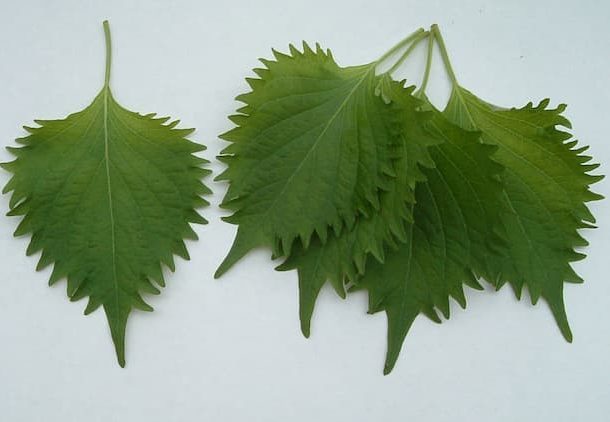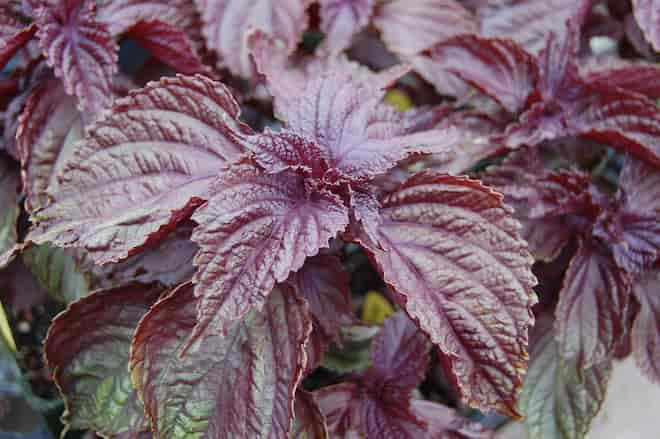Shiso leaves find wide use in the culinary world, particularly in cooking and garnishing. Usually, people prefer them due to their unique flavor and remarkable health benefits.
The shiso plant originally came from China and India. However, it is now readily available globally as an exotic herb with many culinary uses. It is a popular ingredient in Japanese and Korean cuisine. Southeast Asian countries also use this herb in their dishes to obtain a distinct minty or basil-like flavor. The growing popularity of Asian cuisine such as sushi has caused many to embrace its use in their local cuisine.
Shiso is a Japanese name referring to Perilla frutescens, a herb belonging to the mint family. People use different terms to refer to this herb. The most commonly used names include perilla, beefsteak plant, perilla mint, Japanese basil, and Chinese basil. People also use purple mint, red shiso, purple perilla, purple shiso, and purple-red shiso to refer to the red-leaf varieties. In addition, ohba leaves are the same as shiso or perilla leaves. The names change according to the locality or region.
Types of Shiso (Perilla)
The most common varieties of this herb include green, red, and bicolor shiso. Some green and red cultivars have ruffled surfaces. As a result, green shiso leaves resemble those of the stinging nettle. Variegated shiso also exists and often has red and green leaves. These types of shiso vary according to the color or appearance of their leaves. People use them for various purposes depending on the type of cuisine. For instance, the Japanese use red shiso to make flakes for their cuisine. The Vietnamese utilize shiso leaves to make pickles and cook seafood.


The Amazing Benefits of Shiso (Perilla) Leaves
Shiso is a functional food. As a result, it promises more health benefits than those guaranteed under basic nutrition. People across East Asia used different parts of the Shiso plant in folk medicine. Evidence shows that traditional healers prescribed this herb to manage various diseases such as abdominal pain and indigestion.
Shiso leaves contain various unique compounds that account for its positive health effects. Scientists have identified 271 natural compounds responsible for their health-promoting and pharmacological properties.
They are full of antioxidants
Shiso leaves contain many antioxidants. These include phenolic compounds, carotenoids, anthocyanins, and flavonoids. These naturally occurring chemicals help protect against diseases. They do so by eliminating free radicals that cause cell and DNA damage. Thus, they keep all body systems healthy and promote optimal function. Antioxidants also reduce the risk of cardiovascular diseases, cancers, and different metabolic disorders. Generally, red shiso leaves have more antioxidants than green ones. You should, therefore, take more red shiso if your target is to obtain more antioxidants and their many health benefits.
They help treat stomach disorders
Shiso leaves generally help promote gastrointestinal health. Evidence indicates that shiso can benefit people with abdominal pain, constipation, nausea, and vomiting. The Chinese, Indians, and Japanese utilized shiso as a traditional herbal remedy for these conditions. Its analgesic properties help with abdominal pain. It also promotes bowel movement and allows those with constipation to feel better.
They have anti-depressant activity or properties
Shiso leaves have compounds that alleviate depressive symptoms and boost mood. For instance, perillaldehyde is a naturally occurring substance with antidepressant-like effects. The leaves also contain essential oils with anti-depressive properties. They further have caffeic acid, apigenin, and rosmarinic acid, all compounds that can help reverse depression-like behavior. These chemicals justify using shiso leaves as a traditional herbal remedy for depression disorders.
They help with allergy
Shiso leaves naturally have anti-allergic activity. Evidence suggests that this herb contains rosmarinic acid that helps in treating allergic reactions. This compound has anti-inflammatory properties and usually reduces inflammation in people with allergic disorders. Indeed, studies have shown that the rosmarinic acid from shiso can effectively manage allergic asthma and rhinitis. It improves the condition of patients with these diseases by alleviating airway inflammation. This factor might explain the use of shiso in managing coughs in traditional medicine across East Asia.
They have antibacterial and antiviral activity
Traditionally, the Chinese utilized shiso leaves to treat coughs and colds. Their antibacterial and antiviral properties specifically come in handy in managing these conditions. The essential oils in shiso leaves usually help inhibit Gram-positive and Gram-negative bacteria such as Staphylococcus aureus, Pseudomonas aeruginosa, and Escherichia coli. These oils also have antiviral activity. A recent study showed that the perilla (shiso) leaf extract had the same antiviral effect as Remdesivir when managing COVID-19.
The Most Common Uses of Shiso (Perilla) Leaves
Shiso leaves are a famous sushi ingredient. They serve as a garnish and also help prevent intestinal problems. Its medicinal properties usually help avoid possible food poisoning when one eats raw fish that is not fresh in sushi or similar treats.
Shiso leaves also act as a spice and help improve the flavor of soups and other dishes. It is also a healthy ingredient for vegetable salads.
You can also make shiso leaf juice to assist with stomach toning. In addition, this juice can help detoxify the body. Taking the juice also aids in relieving colds, coughs, asthma, and other diseases.
Shiso leaves also serve as an ingredient for a green herbal tea with a minty flavor and aroma. The tea is very refreshing and usually leaves you feeling better. The shiso leaf tea has a calming effect and helps you relax. However, you can take this tea if you have indigestion, infection, or respiratory issues.
Is Shiso (Perilla) Safe to Eat?
Usually, people cultivate this herb for its leaves. The cultivated shiso variety is safe to eat. However, there is inadequate information regarding its safety during pregnancy. Therefore, pregnant women should avoid its use out of caution.
Wild varieties of this plant also exist. However, they are unsuitable for human consumption. They often lack the characteristic shiso scent and contain high perilla ketone concentrations. These attributes make them undesirable and potentially harmful when eaten.
Where Can You Buy or Find Shiso/Perilla Leaves?
You can purchase fresh shiso leaves in grocery stores, particularly those selling Asian and Japanese vegetables. The fresh ones are always better. They usually have a superior taste and smell. If you want to maintain a good supply of fresh shiso leaves, you can grow a few plants in a pot or your garden. Shiso plants require adequate sunlight to produce quality leaves. Therefore, it is preferable you grow them outside.
